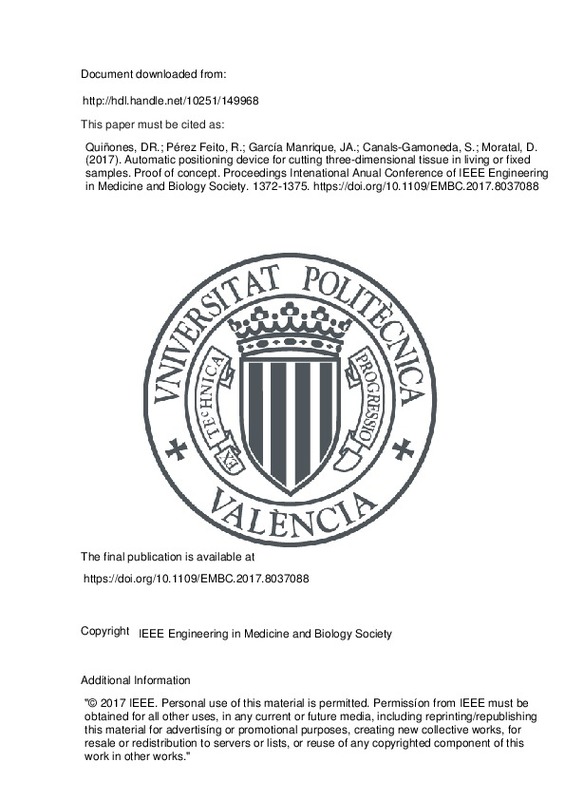Quiñones, DR.; Pérez Feito, R.; García Manrique, JA.; Canals-Gamoneda, S.; Moratal, D. (2017). Automatic positioning device for cutting three-dimensional tissue in living or fixed samples. Proof of concept. Proceedings Intenational Anual Conference of IEEE Engineering in Medicine and Biology Society. 1372-1375. https://doi.org/10.1109/EMBC.2017.8037088
Por favor, use este identificador para citar o enlazar este ítem: http://hdl.handle.net/10251/149968
|
Título:
|
Automatic positioning device for cutting three-dimensional tissue in living or fixed samples. Proof of concept
|
|
Autor:
|
 Quiñones, Darío R.
Quiñones, Darío R.
 Pérez Feito, Ricardo
Pérez Feito, Ricardo

 García Manrique, Juan Antonio
Canals-Gamoneda, Santiago
García Manrique, Juan Antonio
Canals-Gamoneda, Santiago

 Moratal, David
Moratal, David
|
|
Entidad UPV:
|
Universitat Politècnica de València. Departamento de Termodinámica Aplicada - Departament de Termodinàmica Aplicada
Universitat Politècnica de València. Departamento de Ingeniería Mecánica y de Materiales - Departament d'Enginyeria Mecànica i de Materials
Universitat Politècnica de València. Departamento de Ingeniería Electrónica - Departament d'Enginyeria Electrònica
|
|
Fecha difusión:
|
|
|
Resumen:
|
[EN] The study and analysis of tissues has always been an important part of the subject in biology. For this reason, obtaining specimens of tissue has been vital to morphological and functionality research. Historically, ...[+]
[EN] The study and analysis of tissues has always been an important part of the subject in biology. For this reason, obtaining specimens of tissue has been vital to morphological and functionality research. Historically, the main tools used to obtain slices of tissue have been microtomes and vibratomes. However, they are largely unsatisfactory. This is because it is impossible to obtain a full, three-dimensional structure of a tissue sample with these devices.
This paper presents an automatic positioning device for a three-dimensional cut in living or fixed tissue samples, which can be applied mainly in histology, anatomy, biochemistry and pharmacology. The system consists of a platform on which the tissue samples can be deposited, plus two containers. An electromechanical system with motors and gears gives the platform the ability to change the orientation of a sample. These orientation changes were tested with movement sensors to ensure that accurate changes were made.
This device paves the way for researchers to make cuts in the sample tissue along different planes and in different directions by maximizing the surface of the tract that appears in a slice.
[-]
|
|
Palabras clave:
|
Containers
,
Gears
,
Engines
,
Graphical user interfaces
,
Sensors
,
Blades
,
Ice
|
|
Derechos de uso:
|
Reserva de todos los derechos
|
|
Fuente:
|
Proceedings Intenational Anual Conference of IEEE Engineering in Medicine and Biology Society. (issn:
1557-170X
)
|
|
DOI:
|
10.1109/EMBC.2017.8037088
|
|
Editorial:
|
IEEE Engineering in Medicine and Biology Society
|
|
Versión del editor:
|
https://doi.org/10.1109/EMBC.2017.8037088
|
|
Título del congreso:
|
39th Annual International Conference of the IEEE Engineering in Medicine and Biology Society (EMBC 2017)
|
|
Lugar del congreso:
|
Jeju Island, South Korea
|
|
Fecha congreso:
|
Julio 11-15,2017
|
|
Código del Proyecto:
|
info:eu-repo/grantAgreement/MINECO//BFU2015-64380-C2-1-R/ES/TRATAR LA ENFERMEDAD RESINTONIZANDO LA DINAMICA DE LAS REDES CEREBRALES/
info:eu-repo/grantAgreement/MINECO//SEV-2013-0317/ES/-/
info:eu-repo/grantAgreement/MINECO//BFU2015-64380-C2-2-R/ES/ANALISIS DE TEXTURAS EN IMAGEN CEREBRAL MULTIMODAL POR RESONANCIA MAGNETICA PARA UNA DETECCION TEMPRANA DE ALTERACIONES EN LA RED Y BIOMARCADORES DE ENFERMEDAD/
|
|
Descripción:
|
"© 2017 IEEE. Personal use of this material is permitted. Permissíon from IEEE must be obtained for all other uses, in any current or future media, including reprinting/republishing this material for advertisíng or promotional purposes, creating new collective works, for resale or redistribution to servers or lists, or reuse of any copyrighted component of this work in other works."
|
|
Agradecimientos:
|
Research supported in part by the Spanish Ministerio de Economia y Competitividad (MINECO) and FEDER funds under grants BFU2015-64380-C2-2-R and BFU2015-64380-C2-1-R. Santiago Canals acknowledges financial support from the ...[+]
Research supported in part by the Spanish Ministerio de Economia y Competitividad (MINECO) and FEDER funds under grants BFU2015-64380-C2-2-R and BFU2015-64380-C2-1-R. Santiago Canals acknowledges financial support from the Spanish State Research Agency, through the "Severo Ochoa" Programme for Centres of Excellence in R&D (ref. SEV- 2013-0317). Dario Quinones is supported by grant Ayudas para la formacion de personal investigador (FPI) from Universitat Politecnica de Valencia. We are grateful to Begoña Fernández (Neuroscience Institute, Consejo Superior de Investigaciones Científicas - CSIC, Alicante, Spain) for her excellent technical assistance.
[-]
|
|
Tipo:
|
Artículo
Comunicación en congreso
|







![[Cerrado]](/themes/UPV/images/candado.png)


